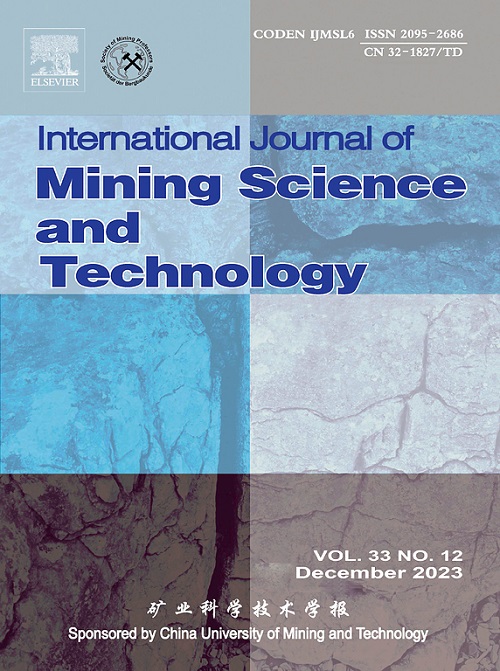成岩变化对珊瑚礁石灰岩静态和动态力学行为的影响
IF 11.7
1区 工程技术
Q1 MINING & MINERAL PROCESSING
International Journal of Mining Science and Technology
Pub Date : 2024-07-01
DOI:10.1016/j.ijmst.2024.07.004
引用次数: 0
摘要
由于复杂的沉积成因作用,不同沉积深度和沉积面的珊瑚礁灰岩在质地和矿物特征方面存在显著差异。为了探索与成岩作用变化相关的孔隙结构和矿物组成对珊瑚礁灰岩力学行为的影响,对浅埋和深埋深度的珊瑚礁灰岩进行了一系列准静态和动态压缩试验以及显微镜检查。结果表明,浅礁灰岩(SRL)属于多孔文石型碳酸盐岩,孔隙率(55.3±3.2)%,孔隙连通性高。相比之下,深礁灰岩(DRL)主要由致密的方解石型碳酸钙组成,孔隙率(4.9±1.6)%和孔隙连通性较低。由致密晶粒框架加固和加硬的 DRL 在动态抗压强度、弹性模量、脆性指数和比能量吸收方面的数值始终远高于 SRL。随着应变速率的增加,两种石灰岩之间的差距进一步拉大。从错综复杂的断裂网络和混合破坏来看,SRL 的破坏模式主要受弱结合界面和生长线等固有缺陷的影响。同样,尽管 DRL 中预先存在的巨孔可能会影响孔隙顶端一定距离的裂纹扩展,但它几乎不会改变 DRL 在冲击下的轴向劈裂破坏。SRL 中应力波的传播和衰减主要受大量介孔引起的反射和扩散以及层间孔隙塌陷和相邻晶粒破碎的能量耗散所控制,而 DRL 中的应力波则高度依赖于孤立巨孔引起的绝缘和衍射。这一过程伴随着由孔隙微裂纹引起的非弹性变形的能量耗散行为。本文章由计算机程序翻译,如有差异,请以英文原文为准。
Effect of diagenetic variation on the static and dynamic mechanical behavior of coral reef limestone
Coral reef limestone at different depositional depths and facies differ remarkably on the textural and mineralogical characteristics, owing to the complex sedimentary diagenesis. To explore the effects of pore structure and mineral composition associated with diagenetic variation on the mechanical behavior of reef limestone, a series of quasi-static and dynamic compression tests along with microscopic examinations were performed on the reef limestone at shallow and deep burial depths. It is revealed that the shallow reef limestone (SRL) is classified as a porous aragonite-type carbonate rock with high porosity (55.3±3.2)% and pore connectivity. In comparison, the deep reef limestone (DRL) is mainly composed of dense calcite-type calcium carbonate with low porosity (4.9±1.6)% and pore connectivity. The DRL strengthened and stiffened by the tight grain framework consistently displays much higher values of the dynamic compressive strength, elastic modulus, brittleness index, and specific energy absorption than those of the SRL. The gap between two types of limestone further increases with an increase in strain rate. It appears that the failure pattern of SRL is dominated by the inherent defects like weak bonding interfaces and growth lines, revealed by the intricate fracturing network and mixed failure. Likewise, although the preexisting megapores in DRL may affect the crack propagation on pore tips to a certain distance, it hardly alters the axial splitting failure of DRL under impacts. The stress wave propagation and attenuation in SRL is primarily controlled by the reflection and diffusion caused by plenty mesopores, as well as an energy dissipation in layer-wise pore collapse and adjacent grain crushing, while the stress wave in DRL is highly hinged on the insulation and diffraction induced by the isolated megapores. This process is accompanied by the energy dissipation behavior of inelastic deformation resulted from the pore-emanated microcracking.
求助全文
通过发布文献求助,成功后即可免费获取论文全文。
去求助
来源期刊

International Journal of Mining Science and Technology
Earth and Planetary Sciences-Geotechnical Engineering and Engineering Geology
CiteScore
19.10
自引率
11.90%
发文量
2541
审稿时长
44 days
期刊介绍:
The International Journal of Mining Science and Technology, founded in 1990 as the Journal of China University of Mining and Technology, is a monthly English-language journal. It publishes original research papers and high-quality reviews that explore the latest advancements in theories, methodologies, and applications within the realm of mining sciences and technologies. The journal serves as an international exchange forum for readers and authors worldwide involved in mining sciences and technologies. All papers undergo a peer-review process and meticulous editing by specialists and authorities, with the entire submission-to-publication process conducted electronically.
 求助内容:
求助内容: 应助结果提醒方式:
应助结果提醒方式:


